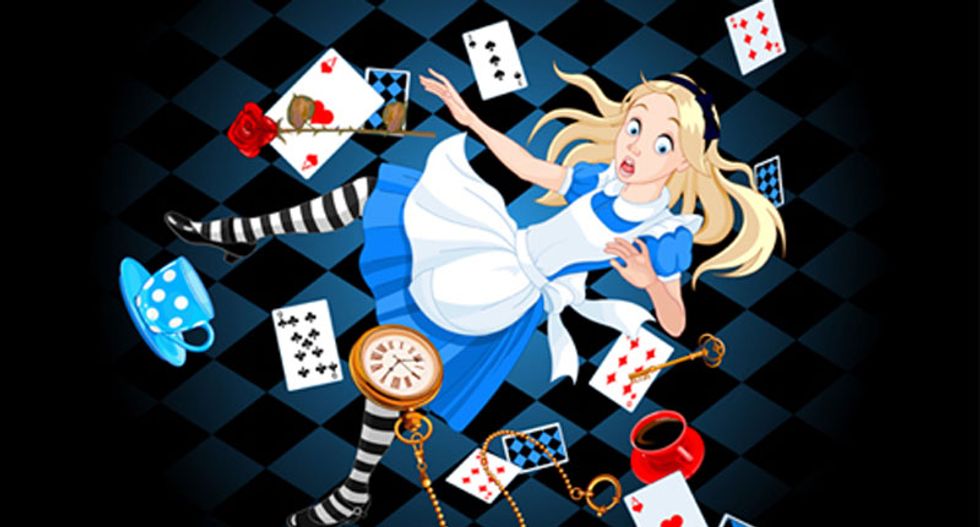
Since a hundred years before Don McLean’s “American Pie” and later-stage Beatles songs came to dominate stoned conversations about lyrical symbolism, one book’s enigmatic appeal has lent itself perfectly to such speculation.
This article was originally published by The Influence, a news site that covers the full spectrum of human relationships with drugs. Follow The Influence on Facebook or Twitter.
Alice’s Adventures in Wonderland, by English author Lewis Carroll (real name: Charles Lutwidge Dodgson), was published in 1865. Its possible allegorical meanings have been picked over with varying degrees of credibility by generations of scholars, students and bloggers.
A fascinating piece by Hephzibah Anderson on the BBC today reviews these myriad interpretations of Alice—ranging from a parable of British colonization to penis envy.
Unsurprisingly for a book in which the heroine drinks potion and eats cake to transform her physical state, drugs loom large in these readings. Anderson writes:
“Of course, sometimes a caterpillar smoking a hookah is just that–especially when he’s flanked by a magical mushroom. Since the 1960s, drug-lovers have read Alice’s antics as one big trip. The lyrics to Jefferson Airplane’s “White Rabbit” did a fair bit to cement the association: “Remember what the Dormouse said / Feed your head, feed your head.” From its heat-addled opening scene, there is a psychedelic vibe—besides all those pills, time moves erratically, and the grinning Cheshire Cat is here one minute, gone the next.”
The caterpillar scene, for example—at the end of which Alice eats two pieces of the magical mushroom, which make her first shrink more and then grow a greatly elongated neck—has a decidedly hazy tone, its circular direction not particularly suggestive of sobriety:
The Caterpillar and Alice looked at each other for some time in silence: at last the Caterpillar took the hookah out of its mouth, and addressed her in a languid, sleepy voice.‘Who are YOU?’ said the Caterpillar.
This was not an encouraging opening for a conversation. Alice replied, rather shyly, `I—I hardly know, sir, just at present—at least I know who I WAS when I got up this morning, but I think I must have been changed several times since then.’
`What do you mean by that?’ said the Caterpillar sternly.
`Explain yourself!’
`I can’t explain MYSELF, I’m afraid, sir’ said Alice, `because I’m not myself, you see.’
`I don’t see,’ said the Caterpillar.
`I’m afraid I can’t put it more clearly,’ Alice replied very politely, `for I can’t understand it myself to begin with; and being so many different sizes in a day is very confusing.’
`It isn’t,’ said the Caterpillar.
`Well, perhaps you haven’t found it so yet,’ said Alice; `but when you have to turn into a chrysalis—you will some day, you know—and then after that into a butterfly, I should think you’ll feel it a little queer, won’t you?’
`Not a bit,’ said the Caterpillar.
`Well, perhaps your feelings may be different,’ said Alice; `all I know is, it would feel very queer to ME.’
`You!’ said the Caterpillar contemptuously. `Who are YOU?’
Which brought them back again to the beginning of the conversation.
But does this mean that Carroll/Dodgson was into drugs? Not really, says Anderson:
“One of Dodgson’s own favourite authors was Thomas De Quincey of Confessions of an English Opium Eater fame, but though he dabbled in homeopathic cold remedies, there is no concrete evidence that he ever experimented with mind-altering drugs.”
Instead, many of the “drug references” supposedly identified in Alice are probably just in our heads, resonating with the LSD-influenced popular culture of the ’60s, ’70s and beyond. Which, as Anderson illustrates, makes them no less fun.
“Still, the druggy associations endure, as a line from The Matrix shows: “You take the blue pill, the story ends, you wake up in your bed and believe whatever you want to believe. You take the red pill, you stay in Wonderland, and I show you how deep the rabbit hole goes.”
This article was originally published by The Influence, a news site that covers the full spectrum of human relationships with drugs. Follow The Influence on Facebook or Twitter.



